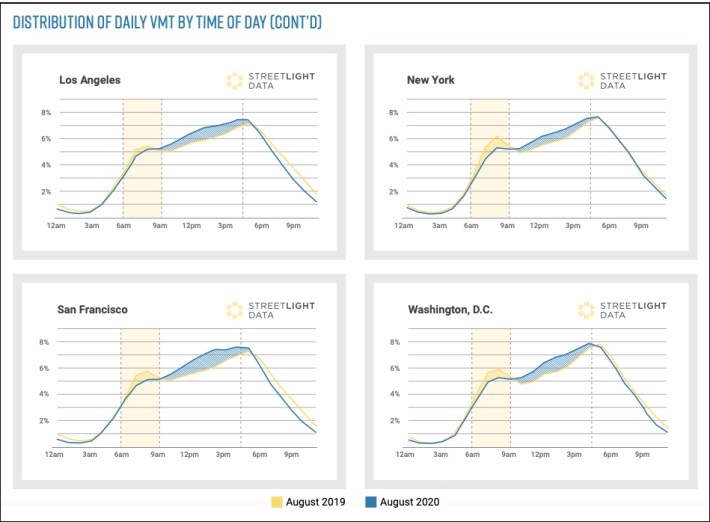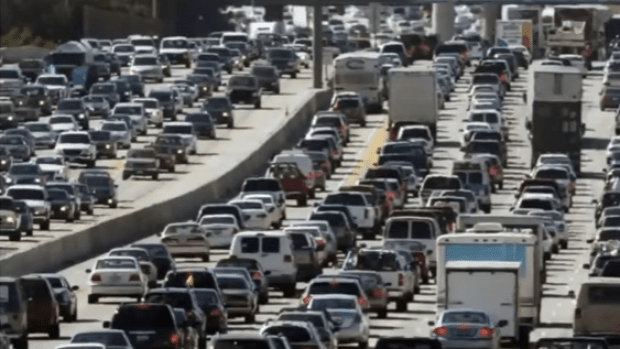Meet the new rush hour. Worse than the old rush hour.
The COVID-19 pandemic hasn’t reduced driving at all — but rather merely spread it out during the day, a new report reveals.
San Francisco-based research firm StreetLight Data looked at traffic patterns in five major metropolitan areas and found that, by August, vehicle miles traveled in each city had rebounded to previous highs. What’s changed is that the morning rush hour — when car travel typically peaked before falling and then building again at about 3 p.m. when schools let out — has been almost eliminated in favor of a spread-out, much-more-intense rush hour from 9 a.m. to 3 p.m.
Each of the five metro areas the firm examined — Chicago, New York, Los Angeles, San Francisco and Washington, D.C. — saw similar morning fall-offs and midday rises in traffic, with some slight regional variations: The two California cities are seeing a “mini rush hour” around lunch time, while the added driving on the East Coast skews more toward later hours. The report attributed the new driving patterns to the rise of remote work during the pandemic, quoting a survey that counted 77 percent of office employees working from home and 55 percent likely to continue doing so after COVID.

“Millions of commuters no longer head to a distant office in the morning, and they have new flexibility for mid-day grocery shopping and other in-person errands as more businesses gradually reopen their doors,” the report said.
The findings have major ramifications for cities as they seek to mitigate what street-safety activists call “Carmageddon” — the wholesale return of traffic to the urban core with its attendant vehicle violence, air pollution and congestion.
In particular, if more car drivers are on roads during daylight hours, when more pedestrians and cyclists are also on streets, cities could see a jump in deaths and injuries from crashes — and, in fact, the rate of deaths and injuries already has jumped in 2020, statistics show.
The vice president of marketing at StreetLight Data, Martin Morzynski, said he was "not sure" the firm's data supports the idea that we will see more injuries and fatalities, but he did point to data showing that American cities are seeing a cycling boom: nationwide, a 12-percent year-over-year gain in biking, on average.
"Increased bike ridership in many cities — and new knowledge about major origin and destination hubs for bikers in these cities — is already informing the creation of bike-dedicated infrastructure aimed at ensuring safety," Morzynski said.
The spread out of VMT during the day also throws a big wrench into the models of transportation planners, underscoring the need for more data and better strategies to deal with the new urban traffic realities — just as municipalities find their budgets sapped by the pandemic. But cities could find some dollars in their highway budgets, Morzynski suggested.
"Because total vehicle miles traveled are ... less concentrated during the a.m.and p.m. rush hours, localities with uncertain budgets need lower-cost, faster sources of data to monitor where and how their populations are moving to deploy resources and infrastructure that meets the evolving demand for transportation," Morzynski said. "This could mean shifting dollars from highway lanes to bike lanes or delivery drop-off zones, as well as revised scheduling of transit, safer loading, adherence to COVID health guidelines, and so on."
The drop-off in a.m. rush hour congestion will likely persist after COVID, he added, thanks to new habits that have been formed, together with sustained gains in e-commerce delivery, sustained work-from-home employer policy and the like.
Unfortunately, some mayors, such as Bill de Blasio of New York, have declined to formulate post-COVID surface-transportation recovery plans, which can feature the measures Morzynski mentioned, along with congestion pricing, high-occupancy vehicle lanes, dedicated bus lanes and busways, and support for transit.
Los Angeles and San Francisco, for two, are trying to take COVID lessons to heart, though: Both cities are pursuing studies to look at congestion pricing and other traffic-reduction strategies. New York’s congestion-pricing plan, which was adopted last year and was supposed to start in January, was halted by President Trump for no apparent reason.






